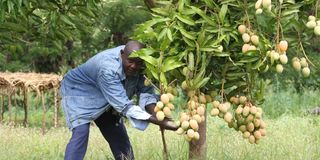Breaking: Autopsy reveals how Cyrus Jirongo died
Makueni: Former sand miners now leading the way in restoring rivers

Daniel Wambua supports a mango orchard at Enguli Village in Makueni County on December 20, 2024. He is among reformed sand miners who have made a fortune from sand conservation. PHOTO| PIUS MAUNDU
What you need to know:
- Through a partnership with African Sand Dam Foundation, a non-governmental organisation which champions for sand conservation to address food and water security, the county government has set up hundreds of sand dams to accelerate the recovery of rivers
At the heart of Enguli Village in Makueni County, Daniel Wambua is looking forward to a bumper maize harvest. A former sand miner, Mr Wambua is part of a rural farming community which taps on sandy riverbeds to beat erratic rainfall.
“We grow assorted vegetables for the better part of the year using irrigation. However, at the height of the dry spell, around October, we plant maize. A month of irrigation before the onset of the short rainy season gives our crops a head start,” the 60-year-old said in a recent interview as he took Healthy Nation around a plot teeming with a lush maize crop. The ingenuity is hinged on availability of water from the nearby River Enguli, a seasonal river which dissects the semi-arid county to drain into River Athi. Until 2014, it was the epitome of wanton sand harvesting.
An ambitious sand conservation campaign which the Makueni County government rolled out a decade ago has transformed Enguli Village from a flashpoint of bloody conflicts between youth allied to sand merchants and a section of the local community opposed to sand harvesting to a sustainable livelihood benchmark. The success story is replicated across the county. In many of the rivers which years of uncontrolled sand harvesting had turned to gaping canyons, the riverbeds are now filled with sand.
The sand conservation campaign has earned Makueni praise from the United Nations Environmental Programme and other stakeholders as well as investments worth millions of shillings. Through a partnership with African Sand Dam Foundation, a non-governmental organisation which champions for sand conservation to address food and water security, the county government has set up hundreds of sand dams to accelerate the recovery of rivers. Enguli Secondary School is among tens of schools and other institutions which depend on such sand dams to quench the thirst of their populations. They use electric pumps to draw water from special tanks which they have set up right below the sandy riverbeds in nearby rivers.
USAID assistant administrator for resilience, environment and food security Mia Beers and Makueni Governor Mutula Kilonzo Junior recently witnessed the commissioning of a state-of-the-art solar pumping system which the county has since deployed to distribute water from a giant underground tank and is recharged by a sand dam at River Kaiti to Wote Town, the county’s administrative capital. “Wote Town requires 4,500,000 liters of water daily. Out of that 2,500, 000 liters of water come from two giant sumps constructed behind two sand dams at River Kaiti. The rest of the water comes from an earth dam and several boreholes around the vibrant town,” Makueni Water Executive John Kieti told Healthy Nation in a recent interview.
According to Halinishi Yusuf, a sand conservation expert and an official of Sand dams Worldwide, a United Kingdom charity which champions the construction of sand dams for suitable livelihoods, sand enables communities in drylands to cope with drought. “Sand acts like a sponge. A sandy riverbed holds a lot of water in the grains of sand during the rainy season which becomes readily available to the community and the ecosystem during the dry season,” she told Healthy Nation. Makueni riparian communities learned the hard way that outstripping a riverbed of sand compromises the ability of the river to hold water during the rainy season.
An insatiable appetite for sand in Nairobi which peaked during the construction of the Standard Gauge Railway line reduced most of the rivers crisscrossing Makueni County into gaping canyons. Before he crossed over to the sand conservation frontline, Mr Wambua was the go-to person when fraudulent sand merchants wanted to bribe administrators and police bosses to insulate them from the wrath of pockets of the community opposed to wanton sand trade.
It took the enactment of the Makueni County Sand Conservation and Utilization Act in 2015 for the sand merchants to surrender. The law has created Makueni sand Authority, an agency which licenses sand traders. The law dictates that the bulk of the proceeds of sand should go into rehabilitating rivers through the construction of sand dams. The rest goes to community projects identified by the riparian communities. The law has earned the county praise at the United Nations Environmental Programme. A team of scientists from three universities who have studied the Kenyan sand industry has also lauded Makueni for streamlining the sand industry.
“In all the counties, with the exception of Makueni, county legislation on sand harvesting is either absent, left hanging or is not being enforced,” reads a section of the report on the sand research which Healthy Nation has seen.
The study led by Professor Kennedy Mkutu of United States International University in Nairobi, Dr Michael Owiso of Maseno University, Dr Jan Bachmann of the University of Gothenburg and Dr Bernard Musembi Kilaka of both the University of Gothenburg and Maseno University calls on the government to take sand conservation seriously in the wake of its growing demand and scarcity.





